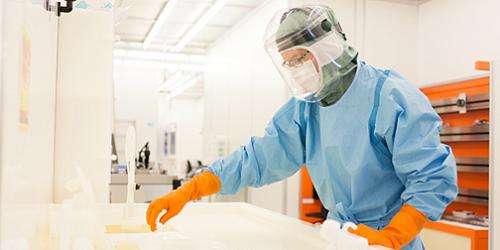Nanotechnology to help in healing hearts

Professor Sami Franssila is participating in a research project that could, if successful, revolutionise the treatment of coronary thrombosis and brain damage.
You cannot walk into the clean rooms of Micronova with your snowy boots.
'We fabricate nano-scale objects so any undesired particles, including dust, must be smaller than the objects being made,' Sami Franssila, Professor of Microtechnology explains and points at the researchers working in their protective clothing on the other side of the window.
'The floor is vibration isolated and the air conditioning keeps the temperature and humidity between precise limits.'
Accelerating stem cell differentiation
Precision is also required in the large strategic research opening by Tekes which Franssila and his research group are participating in with the University of Helsinki and Helsinki University Central Hospital. The project has an ambitious goal: getting damaged organs to heal themselves. Achieving this goal requires drugs that are targeted at an organ, such as the heart or the brain, using nanotechnology. The drugs then locally enhance the differentiation of stem cells so that the necessary new heart or nerve cells are created.
'The idea is to heal cell damages locally,' Sami Franssila explains.
'One of the greatest challenges is determining the essential chemicals which affect the differentiation of cells. The work requires micro and nanotechnology as we, in collaboration with the University of Helsinki Division of Pharmaceutical Chemistry, have to develop an analysis method that is so sensitive that it can be used to examine extremely small amounts of substance consisting of as few as one thousand molecules. In addition to sensitivity, the method also has to be accurate to counterbalance the natural biological fluctuation of the samples taken from the cells,' Franssila continues.
Ten years of cooperation
The researchers do not have to start off with nothing as Franssila has been cooperating with the Division of Pharmaceutical Chemistry in Viikki for ten years. Working with Professor Risto Kostiainen and Professor Tapio Kotiaho, Franssila has participated in developing a method in which sample molecules are ionised using energetic UV light or a strong electric field. The method even works well with non-polar or uncharged molecules that are often left unobserved by other methods. The cooperation has already resulted in three patents, ten doctoral dissertations and over fifty scientific publications. However, it was not always self-evident that the project would be a success.
'Ten years ago it was a risk for all of us: we had to abandon our old networks and start doing something entirely new,' Sami Franssila recollects.
The close, multidisciplinary cooperation will continue in the Tekes project: the stem cells produced by HUS will be analysed in Viikki using chips supplied by Sami Franssila's group. What can be achieved in five years?
'We won't be able to deliver a drug, that's clear. If everything goes perfectly, we will be able to prove the functionality of the method using known chemicals, introduce new molecules of our own and measure changes in cells with unparalleled sensitivity. In the first years, the applications will probably be related to method development, and treatments will follow later,' Sami Franssila admits.
'Since this is a Tekes project, we are also hoping for financial success, be it spin-offs or patents,' he adds.
Provided by Aalto University


















